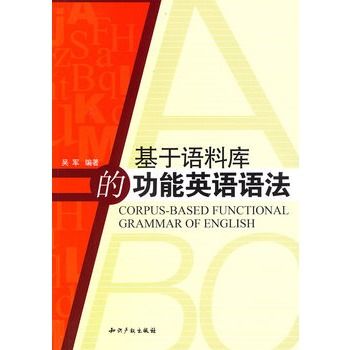《基於語料庫的功能英語語法》是2009年07月智慧財產權出版社出版的圖書,作者是吳軍。《基於語料庫的功能英語語法》是一本以功能為體系的語法書,編著《基於語料庫的功能英語語法》的目的是力求使語法發揮其應有的作用,成為交際的手段和工具,幫助英語學習者提高交際能力。
基本介紹
- 書名:基於語料庫的功能英語語法
- 作者:吳軍
- ISBN:9787802477421、7802477425
- 頁數:290頁
- 出版社:智慧財產權出版社
- 出版時間:2009年07月
- 裝幀:平裝
- 開本:16
- 正文語種:英語
- 條形碼:9787802477421
- 尺寸:25.8 x 18.2 x 1.4 cm
- 重量:458 g
內容簡介,圖書目錄,
內容簡介
《基於語料庫的功能英語語法》實用,例句真實,具體體現在:放海旬(1)以功能為體系的語法書,有別於傳統的以結構為體系的語法書。
(2)建立在語料庫(COBUILD語料庫、LSWE語料庫、CI語料庫)的基礎上,所有例句均來自以上語料庫,真實、鮮活、可靠,具有杜撰戒判籃句所缺禁煉章乏譽講愚的交際價值,此外書中還提供了相關的語料庫檢索結果。
(3)《基於語料庫的功能英語語法》為教師提供了無確定答籃企欠牛案的交際練習再檔殼采活動素材,具有實用價全催值和趣味性。
圖書目錄
1 Reflerring to people and things
1.1 Identifying people and things:nouns
1.1.1 Things that can be counted:countable nouns
1.1.2 Things not usually counted:uncountable nouns
1.1.3 Referring to groups:collectiVe nouns
1.1.4 Referring to materials:material nouns
1.1.5 Referring to abstract concepts,states,qualities and events:abstract
1.1.6 Referring to people and things by name:proper nouns
1.1.7 Nouns ending in-s
1.1.8 Sharing the same quality:adjectives as headwords
1.1.9 Specifying more exactly:compound nouns
Commuicative Practice Activities
1.2 Referring to people and things without naming them:pmnouns
1.2.1 Referring t0 people and things:personal pmnouns
1.2.2 Mentioning possession:possessive pronouns
1.2.3 Referring back to the subject:renexiVe pronouns
1.2.4 Referring to a particular person or thing:demonstmtiVe pronouns
1.2.5 Referring to people and things in a general way:inde6nite pmnouns
1.2.6 Showing that two people do the same thing:recipmcal pmnouns
1.2.7 Joining clauses together:relatiVe pronouns
1.2.8 Asking questions:interrogative pronouns
CommuicatiVe Practice ActiVities
1.3 Identifying what you are talking about:deternliners
1.3.1 Collocations between detenlliners and nouns
1.3.2 Collocations between deteminers
1.3.3 Definite specific reference:the definite article
1.3.4 Indefinite specific reference:the indefinite anicle
1.3.5 Generic reference:the zero anicle
1.3.6 Indefinite determiners
Commuicative Practice Activities
2 Giving inflomation about people and things
2.1 Descrbing things:adjectives
2.1.1 One—word and compound adiectives
2.1.2 Centml and peripheral adjectives
2.1.3 Dynamic and stative adjectives
2.1.4 Grable and non—gradable adjectives
2.1.5 Panicipial adjectives
2.1.6 Descriptors and classifiers
2.1.7 AdjectiVe(phrase)as modifier in noun phmses
2.1.8 Adjective phrases as complement
2.1.9 C0mparison and Comparative Constmctions
Commuicative Practice Activities
2.2 Indicating possession or association:genitive noun
2.2.1 Formation of genitive nouns
2.2.2 Meanings of genitive nouns
2.2.3 Uses of genitive nouns
2.2.4 The independent genitive
2.2.5 The double genitive
Commuicative Practice Activities
2.3 Modifying using nouns:premodifying nouns
2.3.1 Meaning relations expressed by noun+noun sequences
2.3.2 Noun+noun sequences acmss registers
2.3.3 Plural nouns as premodifiers
2.4 Talking about quantities and amounts:panitives
2.4.1 General partitives
2.4.2 Partitives related to the shape of things
2.4.3 Partitive related to volume
2.4.4 Partitives related to the state of action
2.4.5 PartitiVes denoting pairs,groups,flocks,etc.
2.4.6 Partitives denoting measures
2.5 ReflerTing to an exact nunlber of things:numerals
2.5.1 Referring to the number of things:cardinal numbers
2.5.2 Referring to things in a sequence:ordinal numbers
2.5.3 Types of numerical expressions
2.5.4 Tlalking about age
2.5.5 Approximate numbers
Commuicative Practice Activities
2.6 Expanding the noun phrase:postmodifiers
2.6.1 Nouns with prepositional phrases
……
3 Making a message
4 Varying the message
5 Expressing time
6 Expressing manner and place
7 Reporting people's words of thoughts
8 Combining messages
9 The Structure of information
1.2.6 Showing that two people do the same thing:recipmcal pmnouns
1.2.7 Joining clauses together:relatiVe pronouns
1.2.8 Asking questions:interrogative pronouns
CommuicatiVe Practice ActiVities
1.3 Identifying what you are talking about:deternliners
1.3.1 Collocations between detenlliners and nouns
1.3.2 Collocations between deteminers
1.3.3 Definite specific reference:the definite article
1.3.4 Indefinite specific reference:the indefinite anicle
1.3.5 Generic reference:the zero anicle
1.3.6 Indefinite determiners
Commuicative Practice Activities
2 Giving inflomation about people and things
2.1 Descrbing things:adjectives
2.1.1 One—word and compound adiectives
2.1.2 Centml and peripheral adjectives
2.1.3 Dynamic and stative adjectives
2.1.4 Grable and non—gradable adjectives
2.1.5 Panicipial adjectives
2.1.6 Descriptors and classifiers
2.1.7 AdjectiVe(phrase)as modifier in noun phmses
2.1.8 Adjective phrases as complement
2.1.9 C0mparison and Comparative Constmctions
Commuicative Practice Activities
2.2 Indicating possession or association:genitive noun
2.2.1 Formation of genitive nouns
2.2.2 Meanings of genitive nouns
2.2.3 Uses of genitive nouns
2.2.4 The independent genitive
2.2.5 The double genitive
Commuicative Practice Activities
2.3 Modifying using nouns:premodifying nouns
2.3.1 Meaning relations expressed by noun+noun sequences
2.3.2 Noun+noun sequences acmss registers
2.3.3 Plural nouns as premodifiers
2.4 Talking about quantities and amounts:panitives
2.4.1 General partitives
2.4.2 Partitives related to the shape of things
2.4.3 Partitive related to volume
2.4.4 Partitives related to the state of action
2.4.5 PartitiVes denoting pairs,groups,flocks,etc.
2.4.6 Partitives denoting measures
2.5 ReflerTing to an exact nunlber of things:numerals
2.5.1 Referring to the number of things:cardinal numbers
2.5.2 Referring to things in a sequence:ordinal numbers
2.5.3 Types of numerical expressions
2.5.4 Tlalking about age
2.5.5 Approximate numbers
Commuicative Practice Activities
2.6 Expanding the noun phrase:postmodifiers
2.6.1 Nouns with prepositional phrases
……
3 Making a message
4 Varying the message
5 Expressing time
6 Expressing manner and place
7 Reporting people's words of thoughts
8 Combining messages
9 The Structure of information

